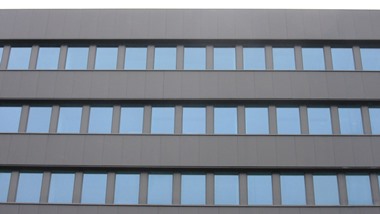Can we help you?
Contact us

Can we help you?
Contact us

Thank you for contacting us
Your form has been submitted successfully Our team will contact you again as soon as possible.
Whooppss...!! An error has occurred
Try sending later or write an email directly to areaempresas@ua.es

 PATENTED TECHNOLOGY
PATENTED TECHNOLOGY
INFO
SHEET
DOWNLOAD
EXECUTIVE
ABSTRACT
CONTACT DETAILS: Research Results Transfer Office-OTRI
University of Alicante
Tel.: +34 96 590 99 59
Email: areaempresas@ua.es
http://innoua.ua.es
The research group of technology and sustainability in the architecture of the University of Alicante, together with the Spanish Association of manufacturers of tiles and ceramic floor tiles (ASCER) and the Institute of technology ceramic (ITC) have developed an innovative thermal conditioning panel in ceramic material able to cool or heat any environment in a simple, sustainable and energy-efficient way.
It requires minimal maintenance and can be deployed using a wide range of designs and configurations. Important advantages are achieved in terms of lightness, aesthetics and cleanliness. They are mainly looking for companies licensing the technology, although, they are also open to technical collaboration.

The technology developed is a thermal conditioning panel in ceramic material, which allows cooling and heating a room. The panel incorporates on its inner surface a pattern of capillary tubes filled with water in contact with the material.
This system transmits heat or cold to the surface of the ceramic material and energy exchange by radiation and light convection currents. It allows cooling or heating the room in which it is housed according to the temperature of water flowing through the capillaries.
The structure of the panel consists of the following items:
• A low-thickness porcelain ceramic tile (3-5 mm).
• A capillary pattern of polypropylene or copper tubes connected to water distribution tubes. Each ceramic piece has an independent capillary pattern that is connected to the water distribution pipes (flow and return) by hoses.
• Adhesive interface. The ceramic piece and the capillary tube pattern are connected by conductive paste adhesive, forming a single piece.
• Thermal insulation layer. This layer insulates the inner face of the panel where the capillary pattern is located.

Various configurations are possible for attachment and anchoring, depending on the design requirements. The size of the panels can also be changed. One solution could be used for removable ceiling systems, measuring 60 x 60 cm, 120 x 60 cm, etc., with low thickness light ceramic pieces. A second option consists of linings with large format panels on the walls and ceiling, of up to 300 x 100 cm and with a thickness of 3 to 5 mm, as shown in the images. Finally, there is also an interesting new solution, which entails fitting large format panels detached from the ceiling in an upright or inclined position, with a ceramic finish on both sides.




MAIN ADVANTAGES
• The technology consists of a cooling and heating system more sustainable and efficient. This system allows the usual air conditioners, forced air convective or hot water radiators to be replaced.
• The installation and fastening system is very simple, so the panels could be easily mounted and dismounted.
• Panels can be arranged horizontally, vertically or any other inclination, applied on walls and ceilings.
• The use of ceramic materials enables greater lightness, so it can take larger formats (up to 300 x 100 mm; thickness 3 to 5 mm)
• Ceramic material panels are more resistant to the effects of humidity, condensation, adsorption of dirt and moisture, as well as a higher mechanical strength.
• Ceramic materials provide greater flexibility in terms of aesthetics and design, so different colour, texture or image could be applied to the walls and ceilings of a room.
INNOVATIVE ASPECTS
The main innovation of system is the use of ceramic materials in the composition of the panel of thermal conditioning. So far it had not been used this material combined with a system of capillary tubes of water distribution.
This material has characteristics that make it ideal for use in sustainable construction, since it is respectful of the environment by containing pottery and polypropylene.
The system, working with moderate water temperatures, allows the use of renewable energy, solar, geothermal or biomass, both in summer and in winter.
The material also provides other benefits such as lightness, easy maintenance and the possibility of establishing custom formats.
The research group is looking for institutions and companies interested in acquiring the technology for commercial exploitation by:
• Licensing agreement.
• Technical cooperation if any industry needs to implement the technology according to their necessities.
This technology is protected by patent application:
• Application number: 201001626.
• Application date: 28th December 2010.
Pollution and Environmental Impact
Engineering, Robotics and Automation
Wood and Furniture
Materials and Nanotechnology
Stone and Marble
Carretera San Vicente del Raspeig s/n - 03690 San Vicente del Raspeig - Alicante
Tel.: (+34) 965 90 9959




